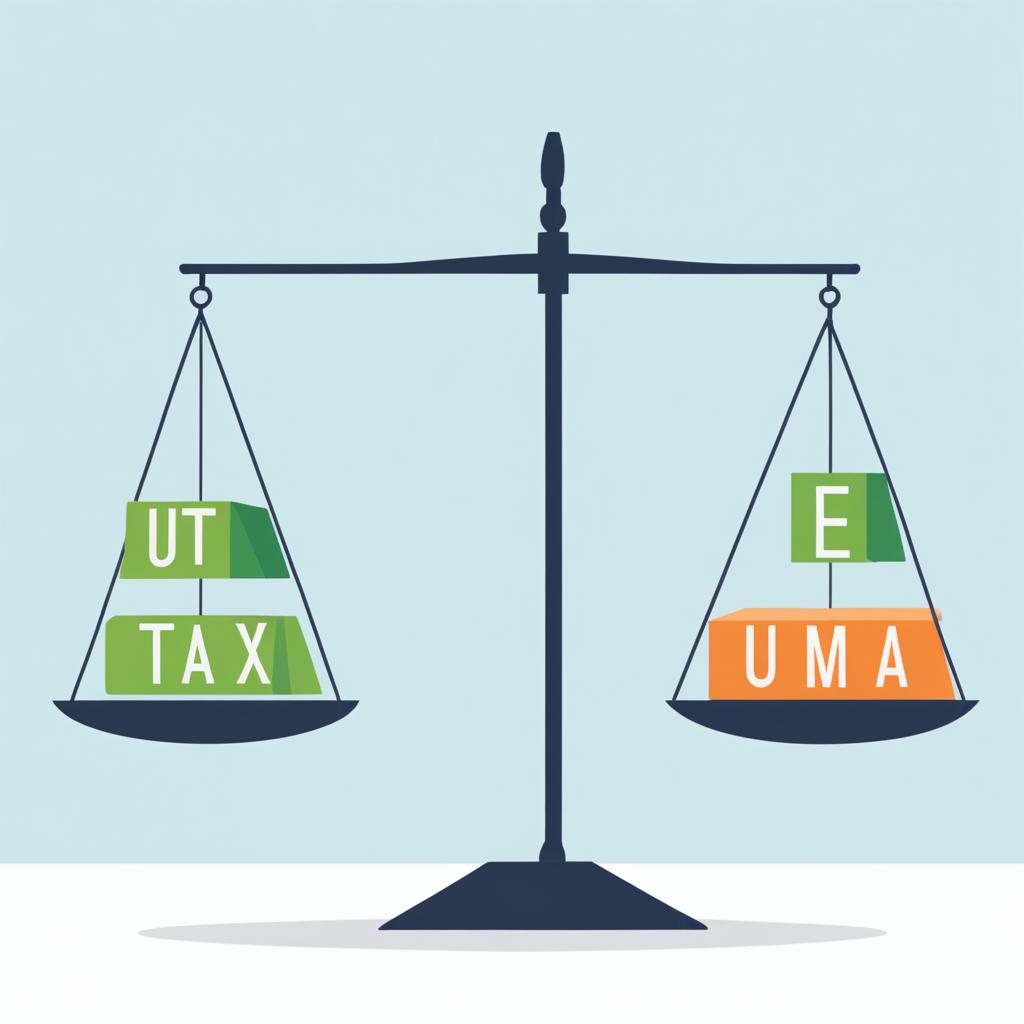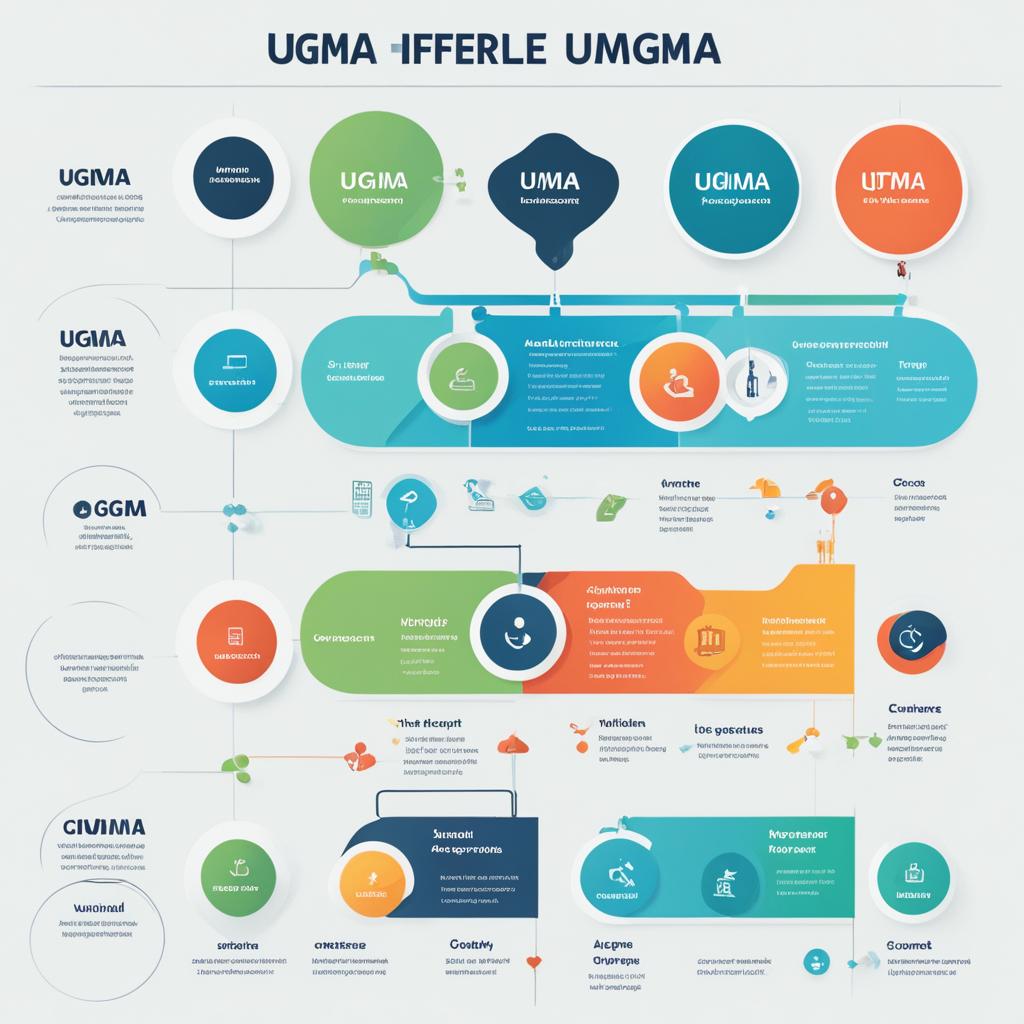When it comes to setting up custodial accounts for minors, two popular options are UGMA (Uniform Gifts to Minors Act) and UTMA (Uniform Transfers to Minors Act) accounts. While these accounts serve similar purposes, there are key differences that can impact your decision. In this article, I will explain the differences between UGMA and UTMA accounts, helping you make an informed choice for your child’s financial future.
Key Takeaways:
- UGMA and UTMA accounts are custodial accounts that adults can set up for minors.
- UGMA accounts are limited to financial products, while UTMA accounts can hold any form of property.
- UGMA accounts are allowed in all states, while UTMA accounts are not permitted in Vermont and South Carolina.
- The age of transfer for UGMA accounts is 18, while UTMA accounts may allow for a later age determined by the state.
- Consider the tax implications and impact on financial aid eligibility when choosing between UGMA and UTMA accounts.
How Do UGMA and UTMA Accounts Work?
UGMA and UTMA accounts function as custodial accounts, where an adult acts as the custodian and manages the assets on behalf of the minor. Once a UGMA or UTMA account is set up, contributions can be made by any individual. The funds in the account belong to the minor, but the custodian has control until the child reaches the age of majority, which is typically between 18 and 21. At that point, the child gains full control of the account and can use the funds as they see fit.
It’s important to consider the age limit imposed by each account. UGMA accounts automatically transfer to the child at age 18, while UTMA accounts may allow for a later age of transfer chosen by the state.
UGMA and UTMA accounts provide a way for adults to manage assets on behalf of minors until they reach adulthood. This allows for financial planning and savings growth over time.
Structure of UGMA and UTMA Accounts
UGMA and UTMA accounts have a similar structure, with a custodian managing the account until the child matures. Here’s a breakdown of the key elements:
- The account is opened and funded by an adult, who becomes the custodian.
- The funds in the account belong to the minor and are held in trust.
- The custodian manages the investments and makes decisions on behalf of the minor.
- The child gains control of the account at the age of majority.
Benefits and Limitations of UGMA and UTMA Accounts
UGMA and UTMA accounts offer a range of benefits that make them attractive options for parents looking to secure their child’s financial future. One of the main advantages is the simplicity and ease of setting up these accounts. Unlike other custodial accounts that require formal custodians or complex legal processes, UGMA and UTMA accounts can be established easily by parents themselves, giving them complete control over the account.
Another benefit of UGMA and UTMA accounts is the security they provide. These accounts offer protection from creditors and other third parties, ensuring that the funds are safeguarded for the child until they reach the age of majority.
However, it’s important to consider the limitations of UGMA and UTMA accounts. Once the funds are deposited into the account, they become the property of the child and cannot be withdrawn or accessed by the depositor. This lack of control over the funds can be a disadvantage for some parents who may have specific financial plans or goals in mind.
Additionally, as the child gains full control of the account at a certain age, their financial decisions may not align with the depositor’s intentions. This can pose challenges if the depositor had specific plans for the funds or preferred a different approach to managing the assets.
“UGMA and UTMA accounts offer simplicity and security, but limitations on control and decision-making may arise.”
It’s essential to carefully consider the benefits and limitations of UGMA and UTMA accounts before making a decision. While they provide an excellent opportunity to save and invest for a child’s future, it’s important to align these accounts with your financial goals and objectives.
| Benefits of UGMA and UTMA Accounts | Limitations of UGMA and UTMA Accounts |
|---|---|
|
|
Tax Implications of UGMA and UTMA Accounts
When it comes to UGMA and UTMA accounts, it’s essential to understand the tax implications. Unlike tax-deferred assets, any gains on investment properties held in UGMA and UTMA accounts are subject to normal taxation. However, the custodian of the account can choose to pay capital gains taxes on behalf of the recipient, potentially reducing their tax burden.
The tax treatment of UGMA and UTMA accounts depends on various factors, including the recipient’s income, dependency status, and other considerations. In some cases, the returns in these accounts may be taxed at the recipient’s tax threshold, resulting in significant tax savings compared to the parent’s income tax bracket.
It’s important to note that while UGMA and UTMA accounts can provide tax advantages, their impact on financial aid eligibility should be taken into account. These accounts can affect the Expected Family Contribution (EFC) calculation, potentially reducing the amount of financial aid a child is eligible to receive.
To fully understand the tax implications of UGMA and UTMA accounts, it’s advisable to consult with a financial advisor or tax specialist who can provide personalized guidance based on your specific circumstances.

Summary:
- UGMA and UTMA accounts are subject to normal taxation on any gains from investment properties held within the accounts.
- The custodian of the account can choose to pay capital gains taxes on behalf of the recipient.
- The tax treatment of UGMA and UTMA accounts depends on the recipient’s income and other factors.
- UGMA and UTMA accounts may provide tax savings compared to the parent’s income tax bracket.
- However, the impact of these accounts on financial aid eligibility should be considered.
- Consult with a financial advisor or tax specialist for personalized guidance on the tax implications of UGMA and UTMA accounts.
UGMA and UTMA Accounts vs 529 College Savings Plans
When it comes to saving for your child’s future, you have several options to consider. Two popular choices are UGMA and UTMA accounts, as well as 529 college savings plans. Each has its advantages and considerations, so it’s important to understand the differences before making a decision.
Investment Options:
One key distinction between UGMA/UTMA accounts and 529 plans is the range of investment options available. UGMA and UTMA accounts offer a broader selection, including stocks, bonds, and mutual funds. You have more flexibility to tailor your investments to your financial goals and risk tolerance. On the other hand, 529 plans typically have predetermined investment options, often limited to cash contributions. While these plans may offer simplicity and ease of use, they may not provide as much customization for your investment strategy.
Usage of Funds:
Another difference lies in the purpose of the funds. UGMA and UTMA accounts allow you to use the funds for any purpose, not just education expenses. This versatility can be beneficial if you want to retain flexibility in how the funds are utilized. On the other hand, 529 plans are specifically designed for college savings. The funds in these accounts can only be used for qualified education expenses, such as tuition, books, and room and board. If your primary goal is to save for your child’s education, a 529 plan may be a more targeted option.
Tax Benefits:
Both UGMA/UTMA accounts and 529 plans offer potential tax advantages. UGMA and UTMA accounts do not provide specific tax benefits, and any gains from investments are subject to normal taxation. However, you may be able to take advantage of the child’s potentially lower tax rate. In contrast, 529 plans offer tax-deferred growth and tax-free withdrawals when used for qualified education expenses. Additionally, some states offer tax deductions or credits for contributions to 529 plans. It’s essential to consult with a tax advisor to understand the specific tax benefits associated with each account.
Ownership and Financial Aid Implications:
UGMA and UTMA accounts are considered the child’s assets, which can have implications for financial aid eligibility. These accounts are assessed at a higher rate compared to parental assets in the Free Application for Federal Student Aid (FAFSA) calculations. On the other hand, 529 plans are typically considered parental assets and may have a lower impact on financial aid eligibility. If financial aid is a significant consideration, you may want to consult with a financial advisor to determine the best strategy for your specific situation.
Conclusion:
When deciding between UGMA and UTMA accounts and 529 college savings plans, it’s crucial to consider factors such as investment options, usage of funds, tax benefits, ownership, and financial aid implications. Each option offers different advantages and considerations, so it’s essential to align your decision with your financial goals and priorities. Consulting with a financial advisor can help you navigate the complexities of these accounts and make an informed choice for your child’s future.

Managing UGMA and UTMA Accounts
As the custodian of a UGMA or UTMA account, I have the responsibility of managing the account on behalf of the minor. This includes making investment decisions and determining any special circumstances where the funds may be withdrawn for the minor’s benefit.
It’s important to consider that once the child reaches the age of majority, they gain full control of the account, and I no longer have control over how the funds are used. This aspect should be taken into account when deciding whether to open a UGMA or UTMA account, as it may impact my ability to have a say in how the funds are spent.

Example of Managing UGMA and UTMA Accounts
Managing my child’s UGMA account has allowed me to teach them about investing and financial responsibility. I carefully analyze investment options and make decisions that align with our long-term goals. It’s important to balance risk and return to ensure the account grows over time. My role as a custodian enables me to guide my child’s financial journey and help them make informed choices.”
In summary, managing UGMA and UTMA accounts involves taking charge of investment decisions and considering the minor’s best interests. However, it’s crucial to keep in mind that once the child gains control, their autonomy over the account’s management is established.
Contributions and Limits of UGMA and UTMA Accounts
When it comes to contributing to UGMA and UTMA accounts, there are no specific limits set by the accounts themselves. These accounts offer flexibility, allowing anyone, including parents, relatives, and friends, to contribute funds for the benefit of the minor. This makes UGMA and UTMA accounts an inclusive and accessible option for those looking to support a child’s financial future.
However, it’s important to keep in mind the implications of gift taxes when making contributions to these accounts. According to IRS regulations, individuals can gift up to $15,000 per year without triggering gift tax consequences. For married couples, the limit is $30,000. Contributions that exceed these amounts may result in gift tax liability, so it’s crucial to be mindful of the tax implications when making larger contributions.
To gain a clear understanding of the gift tax implications of contributing to UGMA and UTMA accounts, it’s wise to consult with a financial advisor or tax specialist. They can provide guidance on how to maximize the benefits of contributing to these accounts while minimizing any potential tax liabilities.
Contributions and Limits of UGMA and UTMA Accounts: An Overview
| Key Points | UGMA Accounts | UTMA Accounts |
|---|---|---|
| Contribution Limits | No specific limits | No specific limits |
| Gift Tax Considerations | Up to $15,000 per year ($30,000 for married couples) without triggering gift tax consequences | Up to $15,000 per year ($30,000 for married couples) without triggering gift tax consequences |
| Consultation | Consult with a financial advisor or tax specialist to understand gift tax implications | Consult with a financial advisor or tax specialist to understand gift tax implications |
Understanding the contribution and gift tax limits associated with UGMA and UTMA accounts is essential for those considering these custodial accounts. By being well-informed and seeking professional advice, individuals can make the most of these accounts while ensuring compliance with tax regulations.
Tax Treatment of UGMA and UTMA Accounts
When it comes to UGMA and UTMA accounts, understanding the tax implications is crucial. Let’s delve into how these accounts are taxed and what you should consider when managing your investments.
Tax-Free Earnings and “Kiddie Tax Rate”
UGMA and UTMA accounts offer some tax advantages. The first $1,050 of earnings in these accounts is tax-free. This means that any income generated within the account, up to this threshold, is not subject to taxation. It’s a great way to maximize returns without worrying about taxes.
However, once the $1,050 limit is reached, the next $1,050 of earnings is taxed at what’s known as the “kiddie tax rate.” This rate is set at 10% and applies to children who are under a specific age. It’s important to check the current age limit for your child to determine if the “kiddie tax rate” is applicable.
Earnings Above $2,100 and Parent’s Tax Rate
Any earnings above $2,100 in UGMA and UTMA accounts are subject to the parent’s tax rate. This means that if the account generates income beyond this threshold, it will be taxed at the parent’s income tax rate for the year.
It’s crucial to keep track of the account’s earnings and consult with a tax professional to determine the tax implications for your specific situation. They can help ensure compliance with tax regulations and guide you on the best strategies to optimize your tax liabilities.
Compliance and Tax Planning
Proper tax planning is essential when managing UGMA and UTMA accounts. By staying informed about the tax treatment of these accounts, you can make informed decisions about financial contributions and withdrawals.
Consider consulting with a tax advisor who specializes in family finances to minimize tax implications and maximize your savings. They can provide personalized guidance based on your financial goals, ensuring that you comply with tax regulations while optimizing your overall tax strategy.
Remember, tax regulations can change over time, so it’s important to stay up to date with the latest updates and seek professional advice to navigate the complexities of UGMA and UTMA account taxation.
| Tax Treatment | UGMA and UTMA Accounts |
|---|---|
| First $1,050 of earnings | Tax-free |
| Next $1,050 of earnings | Taxed at “kiddie tax rate” (10%) |
| Earnings above $2,100 | Subject to parent’s tax rate |
Understanding the tax treatment of UGMA and UTMA accounts is essential to make informed financial decisions. By considering tax implications and seeking professional advice, you can navigate the complexities of tax regulations while maximizing your savings.
Impact on Financial Aid Eligibility
UGMA and UTMA accounts can have a significant impact on a child’s eligibility for financial aid. When it comes to determining how much financial aid a student is eligible to receive, the Free Application for Federal Student Aid (FAFSA) takes into account UGMA and UTMA accounts as the child’s assets. As a result, the value of these accounts is assessed at a higher rate compared to parental assets.
This means that having UGMA or UTMA accounts can potentially reduce the amount of financial aid a child is eligible to receive. Since the value of these accounts is considered part of the child’s assets, it may increase the Expected Family Contribution (EFC). The EFC is the amount of money the family is expected to contribute towards college costs, and a higher EFC can result in a reduced financial aid package.
It’s important for families to consider the impact of UGMA and UTMA accounts on financial aid when deciding whether to open them. While these accounts offer other benefits such as simplicity and security, it’s essential to weigh the potential reduction in financial aid against these advantages.
| UGMA and UTMA Accounts and Financial Aid | Impact |
|---|---|
| Become part of the child’s assets | Assessed at a higher rate |
| Increased Expected Family Contribution (EFC) | Potential reduction in financial aid package |
In considering the impact on financial aid eligibility, families may want to explore other strategies to minimize the effect. Spending down the funds in the UGMA or UTMA accounts before the child reaches college age on educational or welfare-related expenses can reduce the account balance and lower the EFC. Another strategy is to transfer the funds from a UGMA or UTMA account to a 529 college savings plan. 529 plans are considered parental assets, which are assessed at a lower rate for financial aid purposes. By employing these strategies, families can preserve more financial aid eligibility for the child while still benefiting from the advantages of UGMA and UTMA accounts.
It’s important to note that the impact of UGMA and UTMA accounts on financial aid eligibility can vary depending on individual circumstances. Consulting with a financial advisor or a college financial aid office can provide valuable insights and guidance tailored to your specific situation.

Strategies to Minimize Impact on Financial Aid Eligibility
As a parent who has set up UGMA or UTMA accounts for your children, there are strategies you can employ to minimize the impact on their financial aid eligibility. Consider the following methods:
- Spend down the funds: Prior to your child reaching college age, you can strategically use the funds in the account for educational or welfare-related expenses. This can help reduce the account balance, resulting in a lower impact on the Expected Family Contribution (EFC) calculation.
- Transfer to a 529 college savings plan: Another option is to transfer the funds from the UGMA or UTMA account to a 529 college savings plan. Assets held in a 529 plan are considered parental assets, which are assessed at a lower rate for financial aid purposes. This transfer can help preserve more financial aid eligibility for your child while still providing a tax-advantaged way to save for college expenses.
By implementing these strategies, you can mitigate the effect of UGMA and UTMA accounts on your child’s financial aid eligibility while ensuring their educational future is secure.
The Benefits of UGMA and UTMA Accounts
UGMA and UTMA accounts offer several benefits that make them attractive options for parents looking to secure their child’s financial future:
- Simplicity and Security: Setting up a UGMA or UTMA account is a straightforward process that doesn’t require formal custodians or expensive legal processes. By establishing these accounts, parents can create a dedicated financial resource for their child’s future.
- Involving the Child in Investment Decisions: UGMA and UTMA accounts enable parents to introduce their child to the world of finance and investment by allowing them to participate in investment decisions. This hands-on experience can foster financial literacy and responsibility from an early age.
- Prevention of Early Withdrawals and Misuse: By design, UGMA and UTMA accounts keep the funds out of the hands of teenagers until they reach the age of majority. This prevents early withdrawals or potential misuse, ensuring that the funds are available when the child truly needs them.
Consider these benefits when deciding whether to open a UGMA or UTMA account for your child. With their simplicity, opportunities for financial education, and protective measures, UGMA and UTMA accounts can offer a solid foundation for your child’s financial well-being.
Limitations of UGMA and UTMA Accounts
While UGMA and UTMA accounts come with their fair share of benefits, it’s essential to be aware of certain limitations that may impact your decision. Understanding these limitations will help you make an informed choice when considering whether to open a UGMA or UTMA account.
Lack of Control for the Depositor
One limitation of UGMA and UTMA accounts is the lack of control for the depositor. Once funds are deposited into the account, they become the property of the child, and the depositor no longer has any say in how the funds are spent or managed. This loss of control can be a significant consideration, especially if you have specific financial plans or goals for the funds.
Irrevocable Nature of the Accounts
An important limitation to consider is the irrevocable nature of UGMA and UTMA accounts. Once the assets are transferred into the accounts, they cannot be withdrawn by the depositor. This means that the funds are committed to the child’s ownership and use, and you cannot take them back at a later time. It’s essential to carefully evaluate your long-term financial situation and be certain that you can comfortably part with the assets you contribute.
Opening a UGMA or UTMA account requires careful consideration of the limitations involved, including the loss of control over the funds and the irreversible nature of the accounts.
To give you a visual representation of the limitations of UGMA and UTMA accounts, here’s a table outlining their key limitations:
| Limitations | UGMA Accounts | UTMA Accounts |
|---|---|---|
| Lack of Control for the Depositor | Depositor has no control over how the funds are spent. | Depositor has no control over how the funds are spent. |
| Irrevocable Nature of the Accounts | Funds once deposited cannot be withdrawn by the depositor. | Funds once deposited cannot be withdrawn by the depositor. |
Considering these limitations alongside the benefits of UGMA and UTMA accounts will help you make an informed decision that aligns with your financial goals and circumstances.
Deciding Between UGMA and UTMA Accounts
When considering opening a custodial account for a minor, such as a UGMA or UTMA account, it’s important to weigh the options and make an informed decision. There are a few key factors to consider when deciding between UGMA and UTMA accounts.
First, check the regulations in your state to see if both account types are available. While UGMA accounts are widely accepted across all states, UTMA accounts may not be allowed in Vermont and South Carolina. It’s important to ensure that the account type you choose is legally permitted in your state.
Next, consider the types of assets you wish to transfer to the account. UGMA accounts are limited to financial products such as cash, stocks, or bonds. In contrast, UTMA accounts allow for the transfer of any form of property, including real estate, intellectual property, and even valuable collections. If you have specific assets in mind that fall outside the scope of financial products, a UTMA account may be the better choice.
Lastly, consulting with a financial advisor or tax specialist can provide valuable insights into the tax implications and benefits of each account type. They can help you understand the potential tax savings, as well as any tax obligations associated with these custodial accounts. By seeking professional guidance, you can make a more informed decision that aligns with your financial goals and circumstances.
FAQ
What is the difference between UGMA and UTMA accounts?
The primary difference between UGMA and UTMA accounts is in the types of assets that can be held. UGMA accounts are limited to financial products, while UTMA accounts can hold any form of property. Additionally, UGMA accounts automatically transfer to the child at age 18, while UTMA accounts may allow for a later age of transfer chosen by the state.
How do UGMA and UTMA accounts work?
UGMA and UTMA accounts are custodial accounts that adults can set up for minor recipients. The accounts function as trusts that hold assets until the child reaches the age of majority, usually between 18 and 21. The custodian manages the assets on behalf of the minor until they gain control of the account.
What are the benefits and limitations of UGMA and UTMA accounts?
UGMA and UTMA accounts offer simplicity and security, allowing parents to create dedicated accounts for their children without formal custodians or complex legal processes. However, these accounts have limitations, such as lack of control for the depositor and irrevocability once assets are transferred.
What are the tax implications of UGMA and UTMA accounts?
UGMA and UTMA accounts are not tax-deferred assets. The gains on investments in these accounts are subject to normal taxation. The tax treatment depends on the recipient’s income, dependency status, and other factors.
How do UGMA and UTMA accounts compare to 529 college savings plans?
UGMA and UTMA accounts offer a wider range of investment options and can be used for any purpose, while 529 plans have specific investment options and are designed for college savings. Consider the tax benefits, ownership, and financial aid implications when choosing between these account types.
How do I manage a UGMA or UTMA account?
As the custodian, you have the responsibility of managing the account on behalf of the minor. However, once the child reaches the age of majority, they gain full control of the account, and you no longer have control over how the funds are used.
What are the contribution limits for UGMA and UTMA accounts?
UGMA and UTMA accounts do not have specific contribution limits. Anyone can contribute to these accounts, but it’s important to be aware of gift taxes when making contributions.
How are UGMA and UTMA accounts taxed?
The first
FAQ
What is the difference between UGMA and UTMA accounts?
The primary difference between UGMA and UTMA accounts is in the types of assets that can be held. UGMA accounts are limited to financial products, while UTMA accounts can hold any form of property. Additionally, UGMA accounts automatically transfer to the child at age 18, while UTMA accounts may allow for a later age of transfer chosen by the state.
How do UGMA and UTMA accounts work?
UGMA and UTMA accounts are custodial accounts that adults can set up for minor recipients. The accounts function as trusts that hold assets until the child reaches the age of majority, usually between 18 and 21. The custodian manages the assets on behalf of the minor until they gain control of the account.
What are the benefits and limitations of UGMA and UTMA accounts?
UGMA and UTMA accounts offer simplicity and security, allowing parents to create dedicated accounts for their children without formal custodians or complex legal processes. However, these accounts have limitations, such as lack of control for the depositor and irrevocability once assets are transferred.
What are the tax implications of UGMA and UTMA accounts?
UGMA and UTMA accounts are not tax-deferred assets. The gains on investments in these accounts are subject to normal taxation. The tax treatment depends on the recipient’s income, dependency status, and other factors.
How do UGMA and UTMA accounts compare to 529 college savings plans?
UGMA and UTMA accounts offer a wider range of investment options and can be used for any purpose, while 529 plans have specific investment options and are designed for college savings. Consider the tax benefits, ownership, and financial aid implications when choosing between these account types.
How do I manage a UGMA or UTMA account?
As the custodian, you have the responsibility of managing the account on behalf of the minor. However, once the child reaches the age of majority, they gain full control of the account, and you no longer have control over how the funds are used.
What are the contribution limits for UGMA and UTMA accounts?
UGMA and UTMA accounts do not have specific contribution limits. Anyone can contribute to these accounts, but it’s important to be aware of gift taxes when making contributions.
How are UGMA and UTMA accounts taxed?
The first $1,050 of earnings in these accounts is tax-free. The next $1,050 is taxed at the “kiddie tax rate” of 10%, and any earnings above $2,100 are subject to the parent’s tax rate.
Do UGMA and UTMA accounts impact financial aid eligibility?
UGMA and UTMA accounts are considered the child’s assets for financial aid purposes and can potentially reduce the amount of financial aid they are eligible to receive.
What strategies can I use to minimize the impact on financial aid eligibility?
Spending down the funds before the child reaches college age or transferring them to a 529 college savings plan can help reduce the impact on financial aid eligibility.
What are the benefits of UGMA and UTMA accounts?
UGMA and UTMA accounts provide simplicity and security, allow parents to involve their child in investment decisions, and prevent early withdrawals or misuse of funds.
What are the limitations of UGMA and UTMA accounts?
Limitations of UGMA and UTMA accounts include lack of control for the depositor and irrevocability once assets are transferred.
How do I decide between UGMA and UTMA accounts?
Consider whether both account types are available in your state, the types of assets you want to transfer, and consult with a financial advisor or tax specialist to understand the tax implications and benefits.
,050 of earnings in these accounts is tax-free. The next
FAQ
What is the difference between UGMA and UTMA accounts?
The primary difference between UGMA and UTMA accounts is in the types of assets that can be held. UGMA accounts are limited to financial products, while UTMA accounts can hold any form of property. Additionally, UGMA accounts automatically transfer to the child at age 18, while UTMA accounts may allow for a later age of transfer chosen by the state.
How do UGMA and UTMA accounts work?
UGMA and UTMA accounts are custodial accounts that adults can set up for minor recipients. The accounts function as trusts that hold assets until the child reaches the age of majority, usually between 18 and 21. The custodian manages the assets on behalf of the minor until they gain control of the account.
What are the benefits and limitations of UGMA and UTMA accounts?
UGMA and UTMA accounts offer simplicity and security, allowing parents to create dedicated accounts for their children without formal custodians or complex legal processes. However, these accounts have limitations, such as lack of control for the depositor and irrevocability once assets are transferred.
What are the tax implications of UGMA and UTMA accounts?
UGMA and UTMA accounts are not tax-deferred assets. The gains on investments in these accounts are subject to normal taxation. The tax treatment depends on the recipient’s income, dependency status, and other factors.
How do UGMA and UTMA accounts compare to 529 college savings plans?
UGMA and UTMA accounts offer a wider range of investment options and can be used for any purpose, while 529 plans have specific investment options and are designed for college savings. Consider the tax benefits, ownership, and financial aid implications when choosing between these account types.
How do I manage a UGMA or UTMA account?
As the custodian, you have the responsibility of managing the account on behalf of the minor. However, once the child reaches the age of majority, they gain full control of the account, and you no longer have control over how the funds are used.
What are the contribution limits for UGMA and UTMA accounts?
UGMA and UTMA accounts do not have specific contribution limits. Anyone can contribute to these accounts, but it’s important to be aware of gift taxes when making contributions.
How are UGMA and UTMA accounts taxed?
The first $1,050 of earnings in these accounts is tax-free. The next $1,050 is taxed at the “kiddie tax rate” of 10%, and any earnings above $2,100 are subject to the parent’s tax rate.
Do UGMA and UTMA accounts impact financial aid eligibility?
UGMA and UTMA accounts are considered the child’s assets for financial aid purposes and can potentially reduce the amount of financial aid they are eligible to receive.
What strategies can I use to minimize the impact on financial aid eligibility?
Spending down the funds before the child reaches college age or transferring them to a 529 college savings plan can help reduce the impact on financial aid eligibility.
What are the benefits of UGMA and UTMA accounts?
UGMA and UTMA accounts provide simplicity and security, allow parents to involve their child in investment decisions, and prevent early withdrawals or misuse of funds.
What are the limitations of UGMA and UTMA accounts?
Limitations of UGMA and UTMA accounts include lack of control for the depositor and irrevocability once assets are transferred.
How do I decide between UGMA and UTMA accounts?
Consider whether both account types are available in your state, the types of assets you want to transfer, and consult with a financial advisor or tax specialist to understand the tax implications and benefits.
,050 is taxed at the “kiddie tax rate” of 10%, and any earnings above ,100 are subject to the parent’s tax rate.
Do UGMA and UTMA accounts impact financial aid eligibility?
UGMA and UTMA accounts are considered the child’s assets for financial aid purposes and can potentially reduce the amount of financial aid they are eligible to receive.
What strategies can I use to minimize the impact on financial aid eligibility?
Spending down the funds before the child reaches college age or transferring them to a 529 college savings plan can help reduce the impact on financial aid eligibility.
What are the benefits of UGMA and UTMA accounts?
UGMA and UTMA accounts provide simplicity and security, allow parents to involve their child in investment decisions, and prevent early withdrawals or misuse of funds.
What are the limitations of UGMA and UTMA accounts?
Limitations of UGMA and UTMA accounts include lack of control for the depositor and irrevocability once assets are transferred.
How do I decide between UGMA and UTMA accounts?
Consider whether both account types are available in your state, the types of assets you want to transfer, and consult with a financial advisor or tax specialist to understand the tax implications and benefits.
Our Friends
- https://blog.myrawealth.com/insights/ugma-vs-utma
- https://smartasset.com/investing/ugma-vs-utma
- https://districtcapitalmanagement.com/ugma-vs-utma/
Money posts:
 Welcome to W-4 Form: What It Is & How to Fill It Out!
Welcome to W-4 Form: What It Is & How to Fill It Out!
 How to Save Money in College: Effective Strategies (2024)
How to Save Money in College: Effective Strategies (2024)
 What is a Checking Account Buffer? (2024)
What is a Checking Account Buffer? (2024)
 What’s the Difference Between Financial Freedom and Financial Independence in 2024?
What’s the Difference Between Financial Freedom and Financial Independence in 2024?
 What Are the Different Types of Financial Advisors? (2024)
What Are the Different Types of Financial Advisors? (2024)
 Net Worth By Age Stats (+10 Ways to Improve Your Worth!) (2024)
Net Worth By Age Stats (+10 Ways to Improve Your Worth!) (2024)
 Vanguard Personal Advisor Service Review
Vanguard Personal Advisor Service Review
 Wells Fargo Checking Account Bonus Offers for 2024
Wells Fargo Checking Account Bonus Offers for 2024

